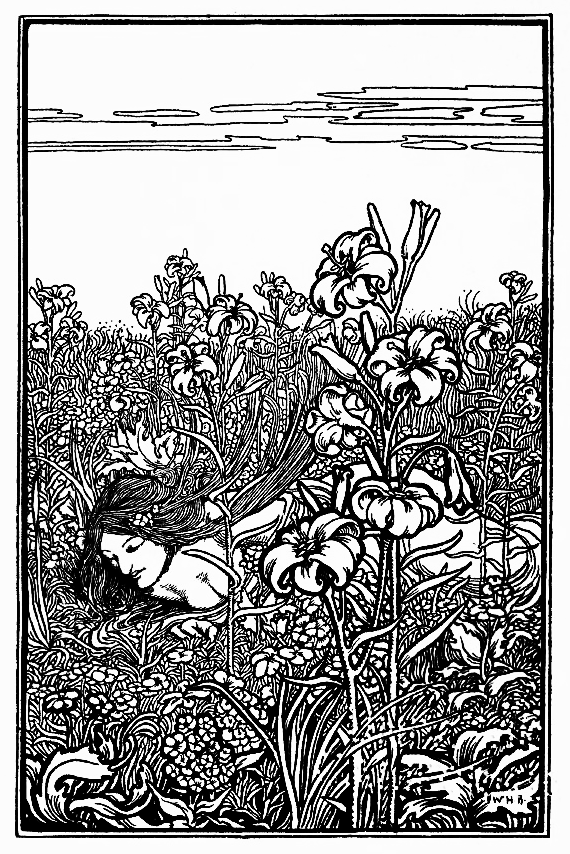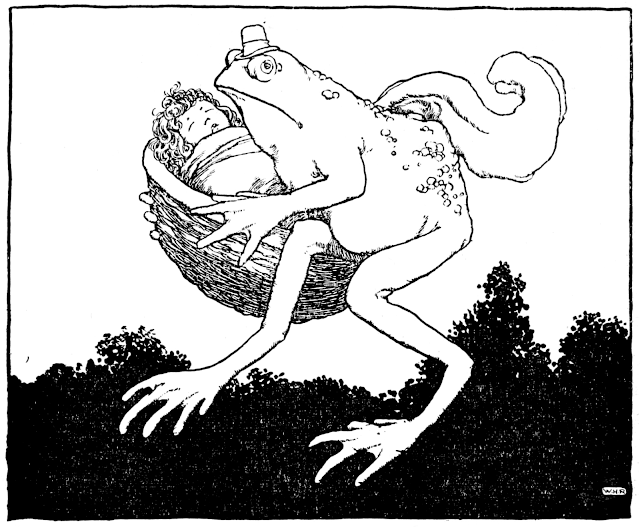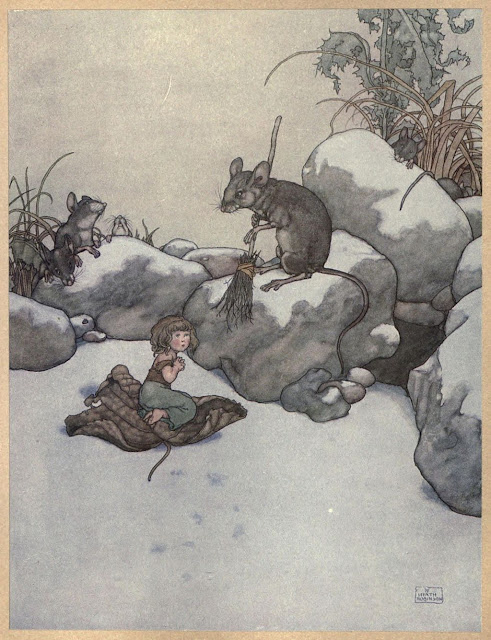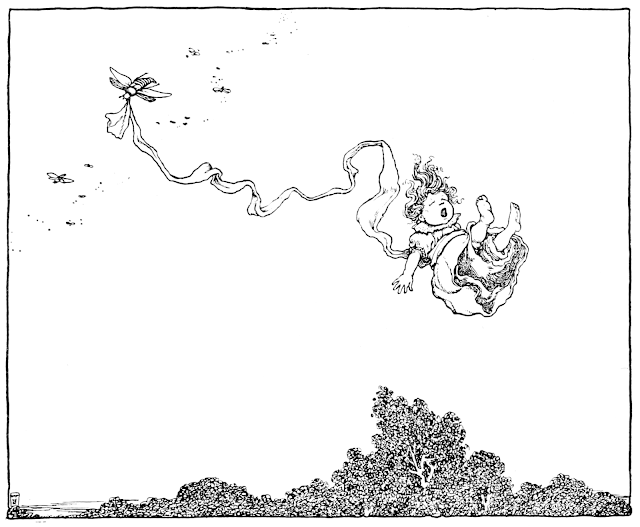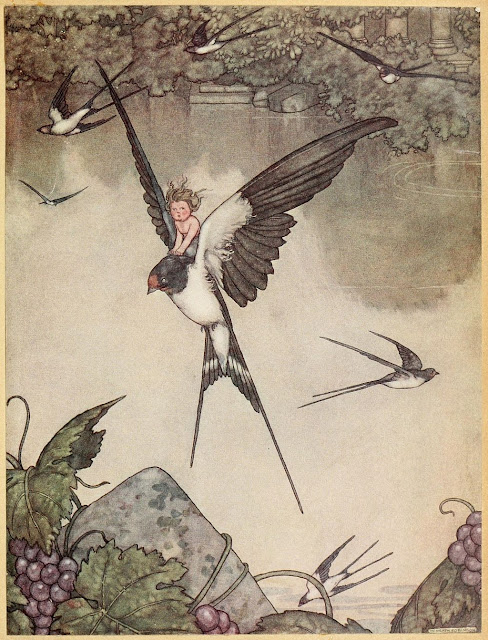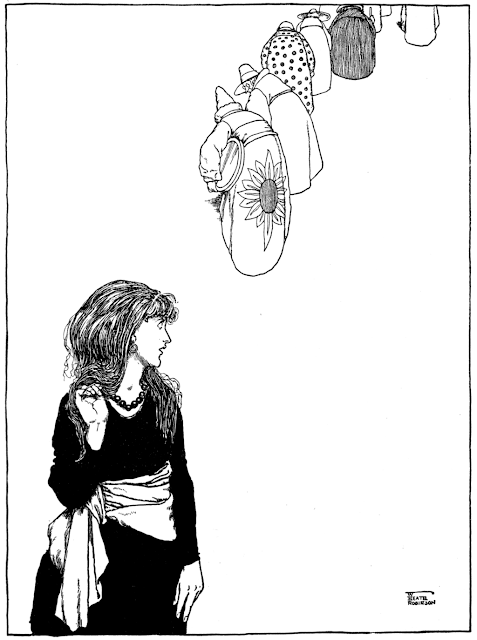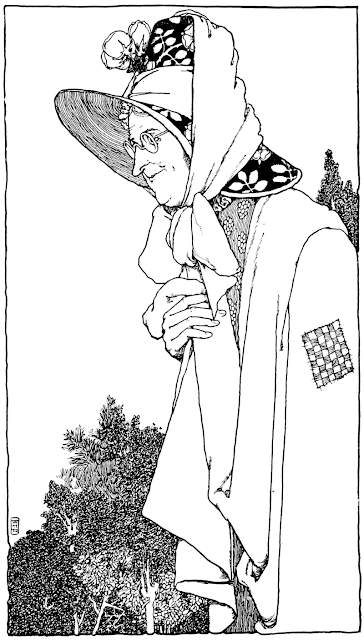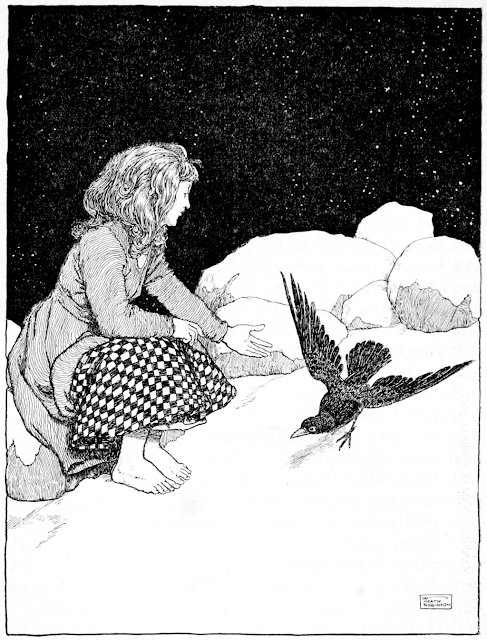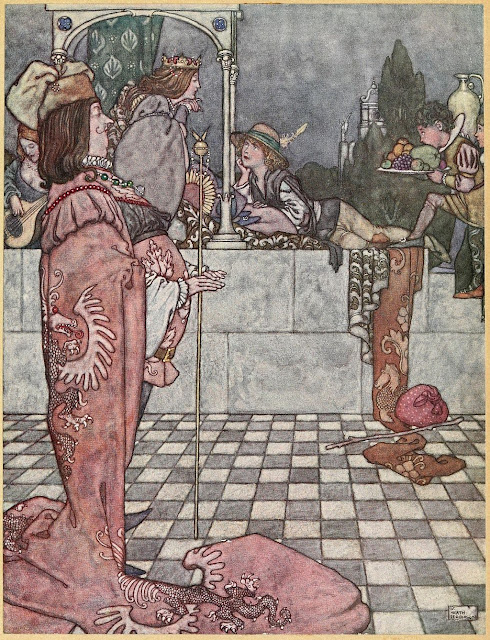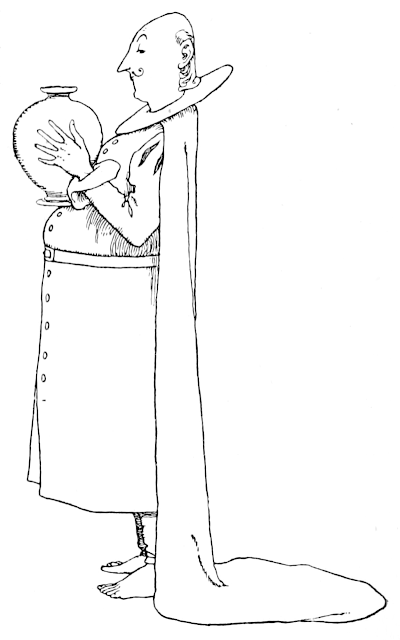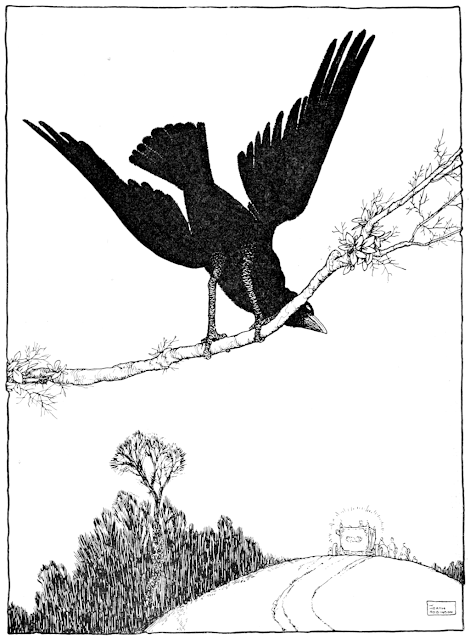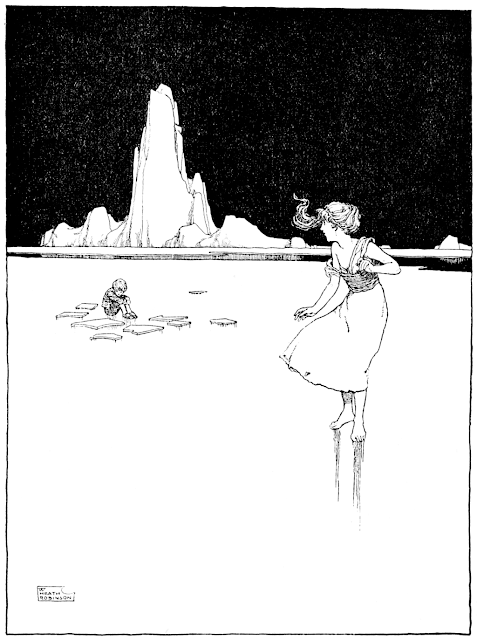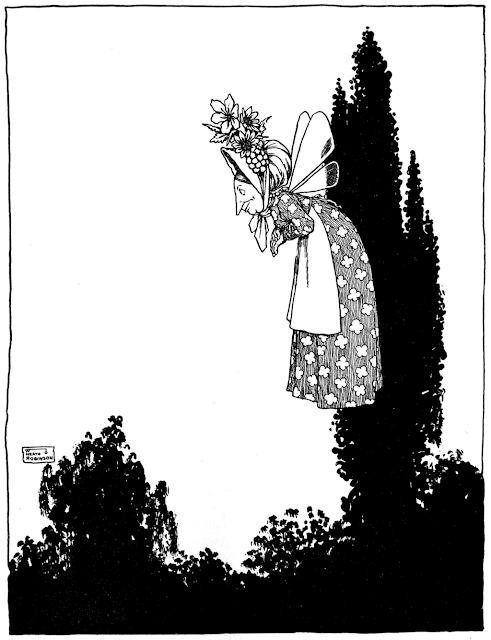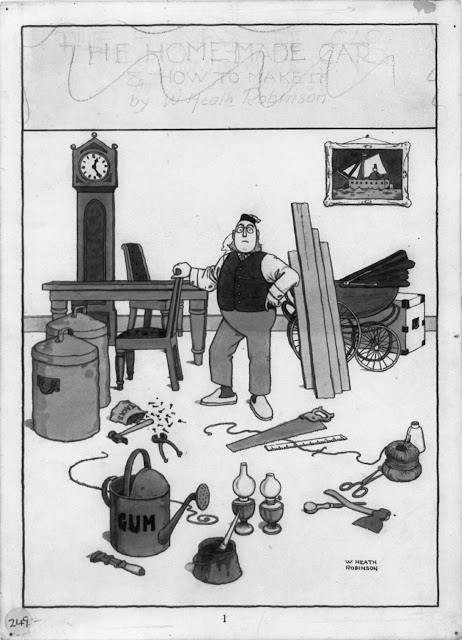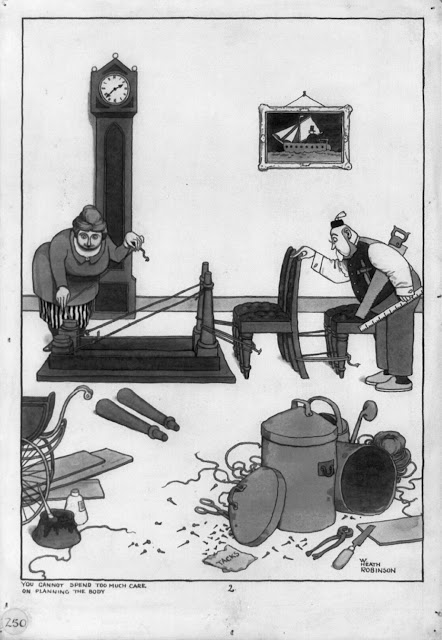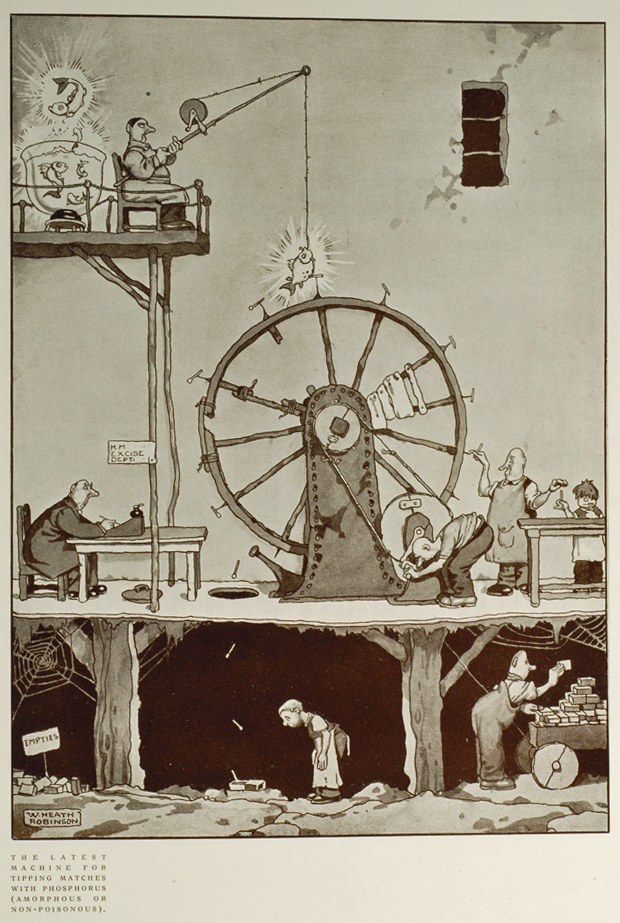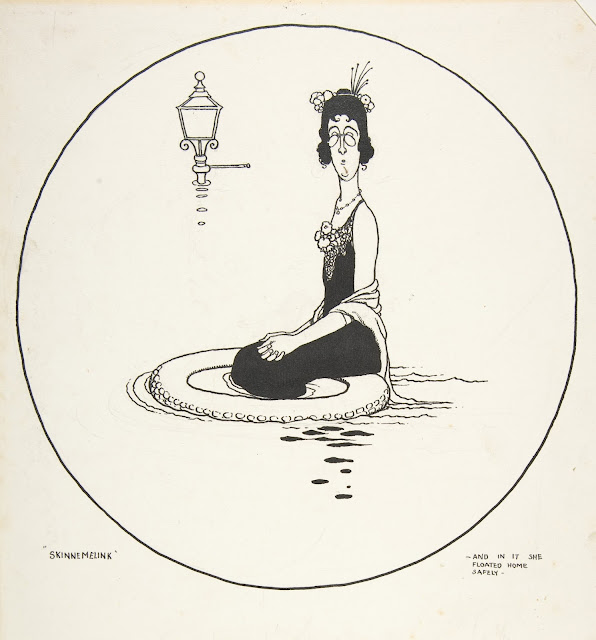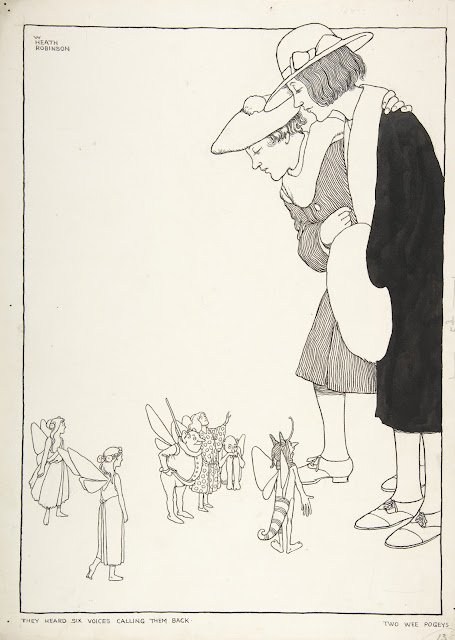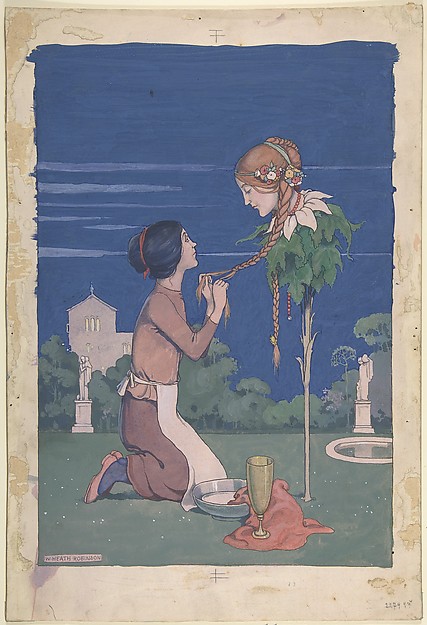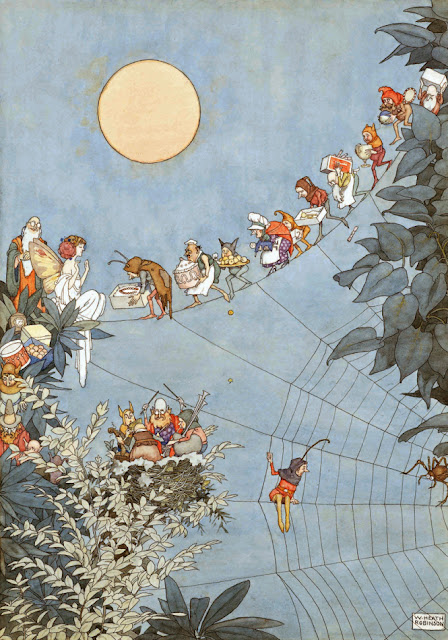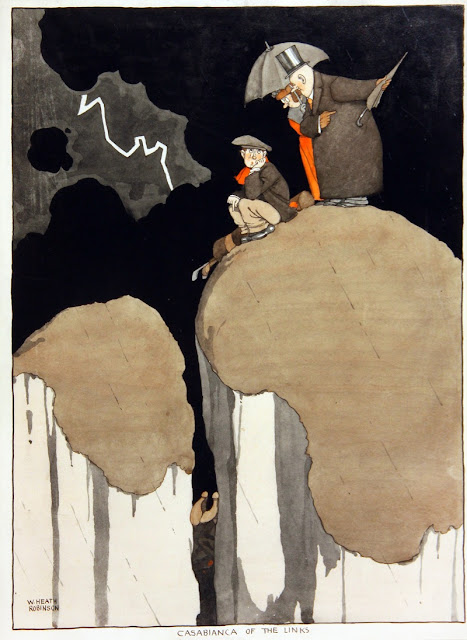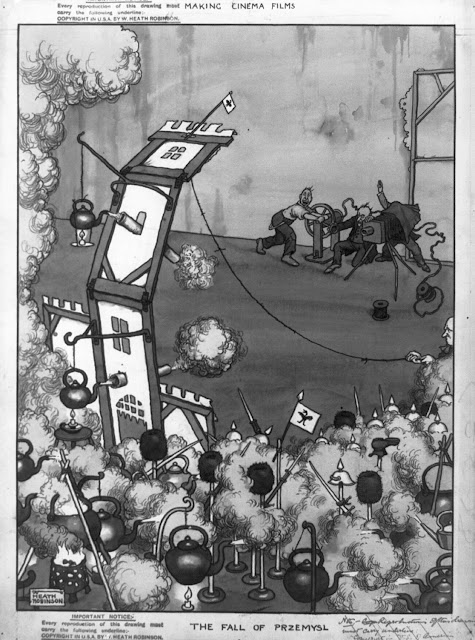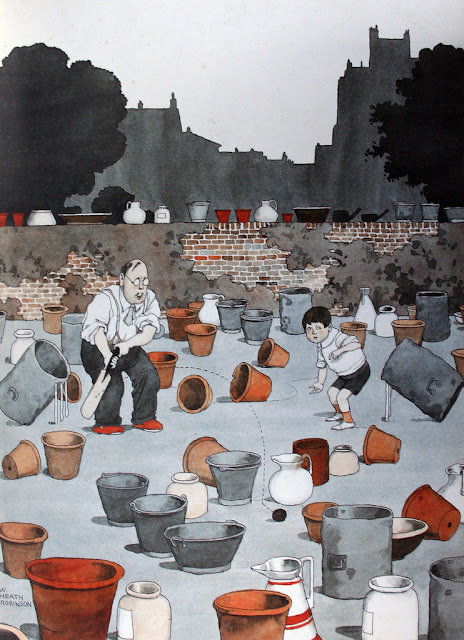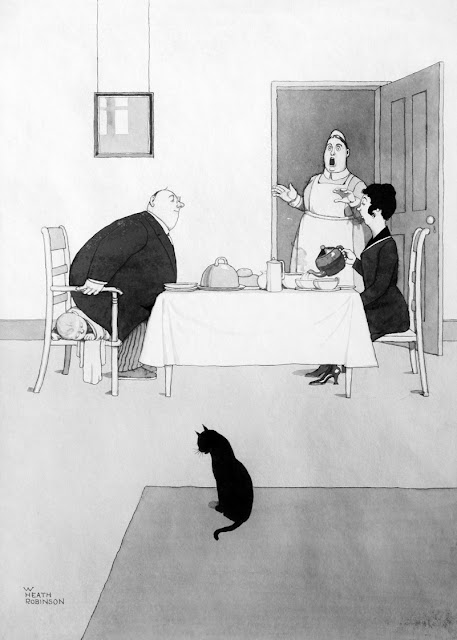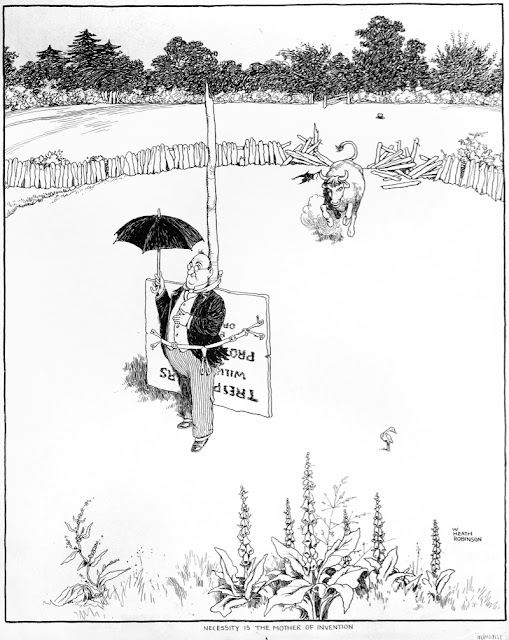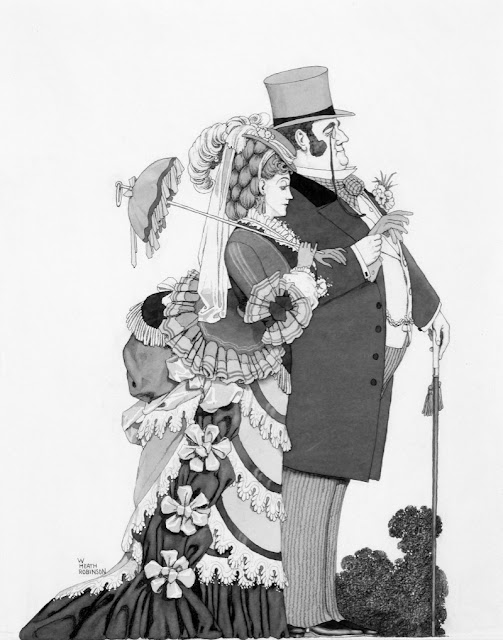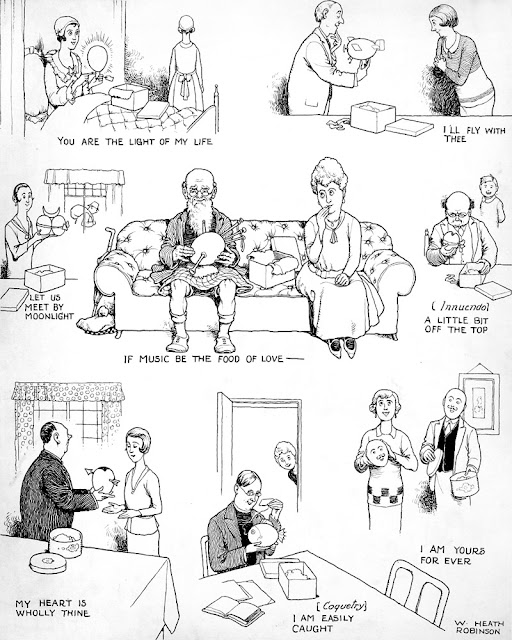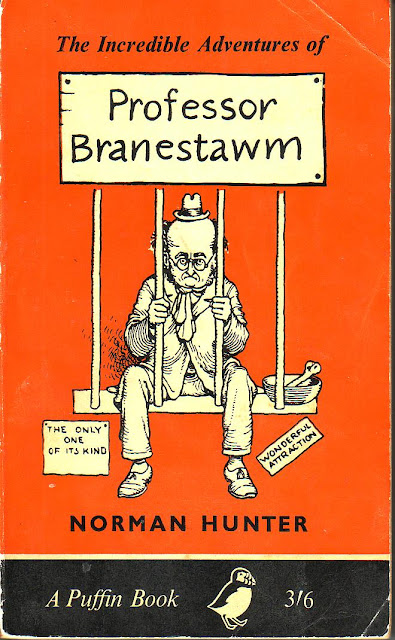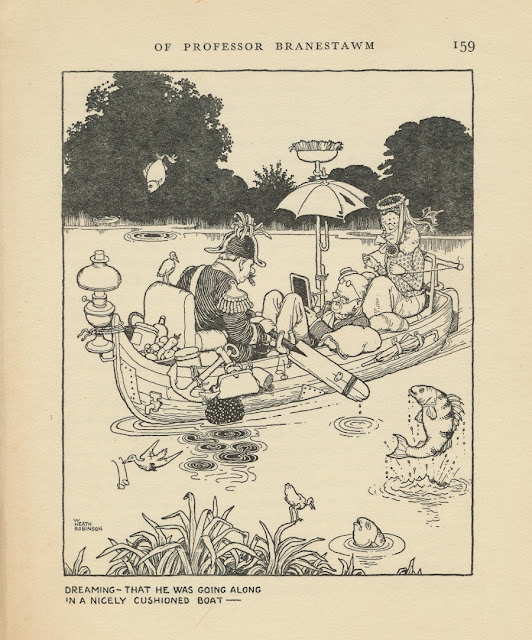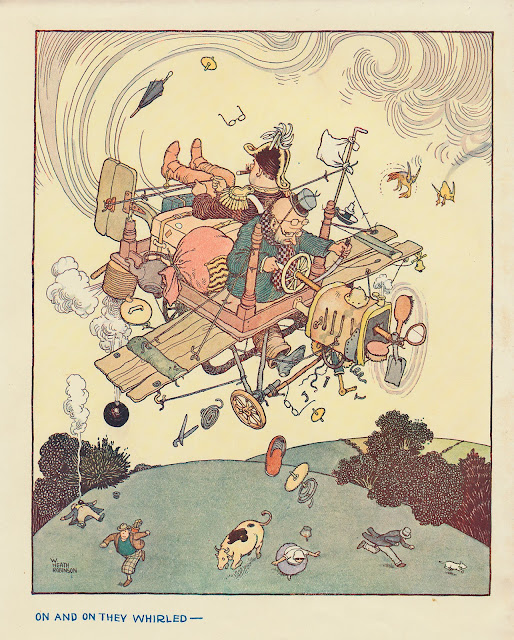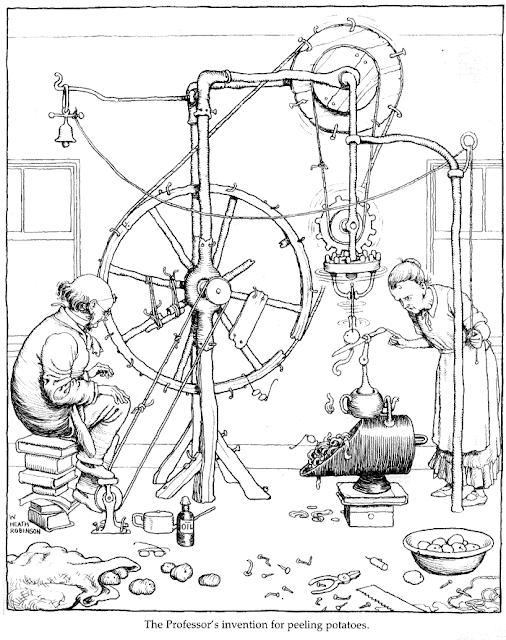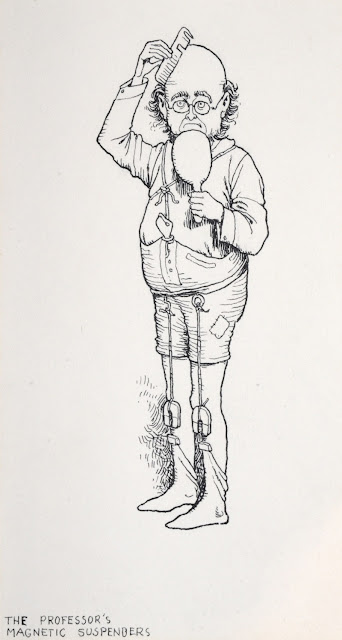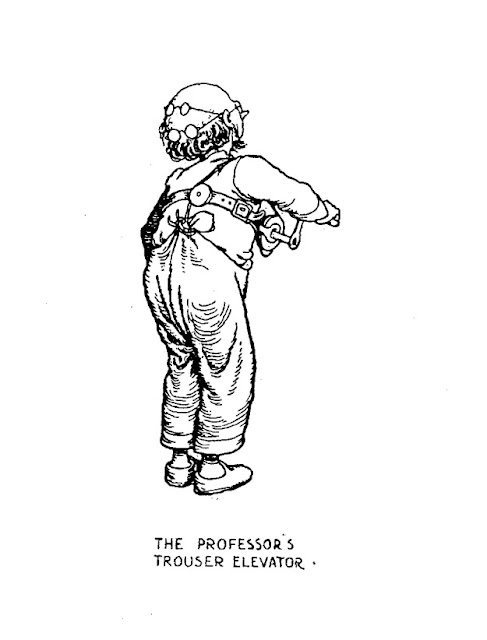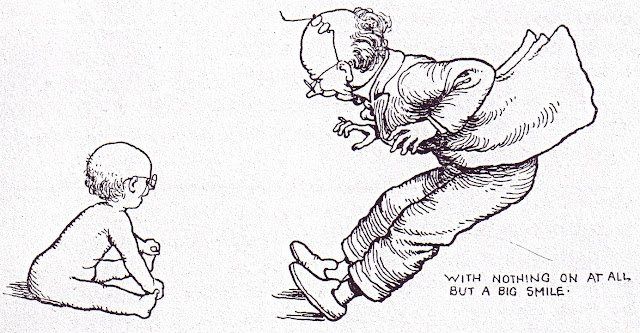November 14, 2015, 6:12 am
William Heath Robinson (1872 – 1944) was an English illustrator and cartoonist, best known for his drawings of complicated machines for achieving simple objectives. “Heath Robinson Contraption” is a phrase that entered the language during WW1 in Britain, and later in the United States.
William wrote and illustrated three highly successful children’s books (The Adventures of Uncle Lubin 1902, Bill the Minder 1912, Peter Quip in Search of a Friend 1933) as well as illustrating numerous others.
In the run up to WW1, Robinson became known for a series of drawings in magazines such as The Sketch and The Tatler, many of which I will be featuring in this comprehensive look at his work.
This is part 2 of a 20 – part series on the works of W. Heath Robinson
1900 Poems of Edgar Allan Poe:
↧
November 16, 2015, 6:16 am
William Heath Robinson (1872 – 1944) was an English illustrator and cartoonist, best known for his drawings of complicated machines for achieving simple objectives. “Heath Robinson Contraption” is a phrase that entered the language during WW1 in Britain, and later in the United States.
William wrote and illustrated three highly successful children’s books (The Adventures of Uncle Lubin 1902, Bill the Minder 1912, Peter Quip in Search of a Friend 1933) as well as illustrating numerous others.
In the run up to WW1, Robinson became known for a series of drawings in magazines such as The Sketch and The Tatler, many of which I will be featuring in this comprehensive look at his work.
This is part 3 of a 20 – part series on the works of W. Heath Robinson
1902 Dent's Andersen in German:
1902 The Adventures of Uncle Lubin:
1903 The Child's Arabian Nights:
![]() |
| Front Cover |
↧
↧
November 18, 2015, 6:58 am
William Heath Robinson (1872 – 1944) was an English illustrator and cartoonist, best known for his drawings of complicated machines for achieving simple objectives. “Heath Robinson Contraption” is a phrase that entered the language during WW1 in Britain, and later in the United States.
William wrote and illustrated three highly successful children’s books (The Adventures of Uncle Lubin 1902, Bill the Minder 1912, Peter Quip in Search of a Friend 1933) as well as illustrating numerous others.
In the run up to WW1, Robinson became known for a series of drawings in magazines such as The Sketch and The Tatler, many of which I will be featuring in this comprehensive look at his work.
This is part 4 of a 20 – part series on the works of W. Heath Robinson
1904 The Works of Mr. Francis Rabelais:
↧
November 20, 2015, 6:00 am
William Heath Robinson (1872 – 1944) was an English illustrator and cartoonist, best known for his drawings of complicated machines for achieving simple objectives. “Heath Robinson Contraption” is a phrase that entered the language during WW1 in Britain, and later in the United States.
William wrote and illustrated three highly successful children’s books (The Adventures of Uncle Lubin 1902, Bill the Minder 1912, Peter Quip in Search of a Friend 1933) as well as illustrating numerous others.
In the run up to WW1, Robinson became known for a series of drawings in magazines such as The Sketch and The Tatler, many of which I will be featuring in this comprehensive look at his work.
↧
November 23, 2015, 5:07 am
William Heath Robinson (1872 – 1944) was an English illustrator and cartoonist, best known for his drawings of complicated machines for achieving simple objectives. “Heath Robinson Contraption” is a phrase that entered the language during WW1 in Britain, and later in the United States.
William wrote and illustrated three highly successful children’s books (The Adventures of Uncle Lubin 1902, Bill the Minder 1912, Peter Quip in Search of a Friend 1933) as well as illustrating numerous others.
In the run up to WW1, Robinson became known for a series of drawings in magazines such as The Sketch and The Tatler, many of which I will be featuring in this comprehensive look at his work.
↧
↧
November 25, 2015, 6:08 am
William Heath Robinson (1872 – 1944) was an English illustrator and cartoonist, best known for his drawings of complicated machines for achieving simple objectives. “Heath Robinson Contraption” is a phrase that entered the language during WW1 in Britain, and later in the United States.
William wrote and illustrated three highly successful children’s books (The Adventures of Uncle Lubin 1902, Bill the Minder 1912, Peter Quip in Search of a Friend 1933) as well as illustrating numerous others.
In the run up to WW1, Robinson became known for a series of drawings in magazines such as The Sketch and The Tatler, many of which I will be featuring in this comprehensive look at his work.
↧
November 27, 2015, 6:13 am
William Heath Robinson (1872 – 1944) was an English illustrator and cartoonist, best known for his drawings of complicated machines for achieving simple objectives. “Heath Robinson Contraption” is a phrase that entered the language during WW1 in Britain, and later in the United States.
William wrote and illustrated three highly successful children’s books (The Adventures of Uncle Lubin 1902, Bill the Minder 1912, Peter Quip in Search of a Friend 1933) as well as illustrating numerous others.
In the run up to WW1, Robinson became known for a series of drawings in magazines such as The Sketch and The Tatler, many of which I will be featuring in this comprehensive look at his work.
↧
November 30, 2015, 4:39 am
William Heath Robinson (1872 – 1944) was an English illustrator and cartoonist, best known for his drawings of complicated machines for achieving simple objectives. “Heath Robinson Contraption” is a phrase that entered the language during WW1 in Britain, and later in the United States.
William wrote and illustrated three highly successful children’s books (The Adventures of Uncle Lubin 1902, Bill the Minder 1912, Peter Quip in Search of a Friend 1933) as well as illustrating numerous others.
In the run up to WW1, Robinson became known for a series of drawings in magazines such as The Sketch and The Tatler, many of which I will be featuring in this comprehensive look at his work.
↧
December 2, 2015, 6:36 am
William Heath Robinson (1872 – 1944) was an English illustrator and cartoonist, best known for his drawings of complicated machines for achieving simple objectives. “Heath Robinson Contraption” is a phrase that entered the language during WW1 in Britain, and later in the United States.
William wrote and illustrated three highly successful children’s books (The Adventures of Uncle Lubin 1902, Bill the Minder 1912, Peter Quip in Search of a Friend 1933) as well as illustrating numerous others.
In the run up to WW1, Robinson became known for a series of drawings in magazines such as The Sketch and The Tatler, many of which I will be featuring in this comprehensive look at his work.
This is part 10 of a 20 – part series on the works of W. Heath Robinson
1913 Hans Andersen's Fairy Tales (part 1):
![]() |
| Front Cover |
![]() |
| Front Cover 2 |
![]() |
| Frontispiece |
![]() |
| Title Page |
![]() |
| She Understood the Speech of Birds |
![]() |
| It Was He Who Pulled Her Down |
![]() |
| The Nile Flood Had Returned |
![]() |
| There Was a Little Bird That Beat it's Wings |
![]() |
| Placed the Golden Circuit About His Neck |
![]() |
| Then She Saw The Storks |
![]() |
| TOMMELISE The Swallow Soared High into the Air |
![]() |
| 'Thou Poor Little Thing!' Said the Field-Mouse |
![]() |
| 'This Is Just The Wife For My Son,' Said The Toad |
![]() |
| She Stood At The Door And Begged For a Piece Of Barley-Corn |
![]() |
| Oh. How Terrified Was Poor Tommelise |
![]() |
| 'Yes! I Will Go With Thee' Said Tommelise, And She Seated Herself On The Bird's Back |
![]() |
| That Was The Greatest Of Pleasures |
![]() |
| THE SNOW QUEEN They Carried The Mirror From Place To Place |
![]() |
| He Chuckled With Delight |
![]() |
| She Wore a Large Hat, With Most Beautiful Flowers Painted On It |
![]() |
| The Swing Moves And The Bubbles Fly Upward With Bright, Ever-Changing Colours |
![]() |
| Gerda Knew Every Flower In The Garden |
![]() |
| Suddenly a Large Raven Hopped Upon The Snow In Front Of Her |
![]() |
| 'He Did Not Come To Woo Her,' He Said, 'He Had Only Come To Hear The Wisdom Of The Princess' |
![]() |
| Cabinet Councillors Were Walking About Barefooted |
![]() |
| And The Nearer They Were To The Door The Prouder They Looked |
![]() |
| And Flapped His Black Wings At The Carriage Till It Was Out Of Sight |
![]() |
| The Little Robber-Maiden |
![]() |
| She Ran On As Fast As She Could |
![]() |
| She Entered The Large, Cold, Empty Hall |
![]() |
| THE ELFIN MOUNT The Elfin King's Housekeeper |
![]() |
| The Mer-King Must Be Invited First |
![]() |
| Round And Round They Went, Such Whirling and Twirling |
![]() |
| They Felt Quite As If They Were At Home |
![]() |
| I Will Have Thee Myself To Wife |
![]() |
| THE LITTLE MERMAID |
![]() |
| She Put The Statue In Her Garden |
![]() |
| She Was On The Whole a Sensible Sort of Lady |
![]() |
| The Youngest Was The Most Lovely |
![]() |
| They Ate From Their Hands |
![]() |
| Many an Evening She Rose To The Place |
![]() |
| When The Sun Arose She Awoke |
![]() |
| With The Rest Of The Children Of Air, Soared High Above The Rosy Cloud |
![]() |
| THE STORKS Father-Stork |
![]() |
| 'Stork! Stork! Long Legged Stork!' |
![]() |
| And Fetch One For Each Of The Boys |
![]() |
| We Will Bring Hm Two Little Ones, a Brother And a Sister |
Note: Hans Andersen's Fairy tales continues in part 11.
↧
↧
December 5, 2015, 6:59 am
William Heath Robinson (1872 – 1944) was an English illustrator and cartoonist, best known for his drawings of complicated machines for achieving simple objectives. “Heath Robinson Contraption” is a phrase that entered the language during WW1 in Britain, and later in the United States.
William wrote and illustrated three highly successful children’s books (The Adventures of Uncle Lubin 1902, Bill the Minder 1912, Peter Quip in Search of a Friend 1933) as well as illustrating numerous others.
In the run up to WW1, Robinson became known for a series of drawings in magazines such as The Sketch and The Tatler, many of which I will be featuring in this comprehensive look at his work.
This is part 11 of a 20 – part series on the works of W. Heath Robinson
1913 Hans Andersen's Fairy Tales (part 2):
![]() |
| THE NIGHTINGALE 'Oh! How Pretty That Is!' He Would Say |
![]() |
| Then Began the Nightingale To Sing |
![]() |
| Among the Branches Dwelt a Nightingale |
![]() |
| They Admired the City, the Palace, and the Garden |
![]() |
| The Kitchen-Maid |
![]() |
| The Chief Imperial Nightingale Bringer |
![]() |
| He Was Quite as Successful as the Real Nightingale |
![]() |
| The Peasant's Wife Sat On Sundays at the Door of Her Cottage Reading Her Hymn Book |
![]() |
| So Elise Took Off Her Clothes and Stepped into the Water |
![]() |
| And Met an Old Woman With a Basket Full of Berries |
![]() |
| Not a Boat Was to be Seen |
![]() |
| There Was Only Just Room For Her and Them |
![]() |
| I Must Venture to the Church-Yard |
![]() |
| THE REAL PRINCESS I Have Scarcely Closed My Eyes the Whole Night Through |
![]() |
| Princesses He Found in Plenty, But Whether They Were Real Princesses it Was Impossible For HIm to Decide |
![]() |
| The Old King Himself Went Out to Open It |
![]() |
| The Peas Were Preserved in the Cabinet of Curiosities |
![]() |
| THE RED SHOES Karen |
![]() |
| She Sat Down One Day and Made Out of Some Old Pieces of Red Cloth, a Pair of Little Shoes |
![]() |
| And Karen was Dressed Very Neatly |
![]() |
| Karen and the Old Lady Walked to Church |
![]() |
| He Sat There Nodding at Her |
![]() |
| Dance She Must, Over Field and Meadow |
![]() |
| THE EMPEROR'S NEW CLOTHES Two Rogues Calling Themselves Weavers Made Their Appearance |
![]() |
| 'Oh, It Is Excellent!' Replied the Minister |
![]() |
| As if in the Act of Holding Something Up |
![]() |
| So Now the Emperor Walked Under His High Canopy |
![]() |
| THE SWINEHERD |
![]() |
| All Cares and Sorrows Were Forgotten by Him Who Inhaled its Fragrance |
![]() |
| 88 And He Wept Like a Child |
![]() |
| 'Ach! Du Lieber Augustin' |
![]() |
| The Swineherd Scolded and the Rain Poured Down |
![]() |
| THE FLYING TRUNK And Flew the Trunk |
![]() |
| The Son Lived Merrily |
![]() |
| He Met a Nurse |
![]() |
| 'Will You Tell us a Story?' Asked the Queen |
![]() |
| But Make it Let Us Laugh, Said the King |
![]() |
| Their Slippers Flew About Their Ears |
![]() |
| She Sat the Live-Long day Upon the Roof of Her Palace, Expecting Him |
![]() |
| THE LEAPING MATCH |
![]() |
| The Old Councillor |
![]() |
| 'I Say Nothing For the Present,' Remarked the King |
![]() |
| THE SHEPHERDESS AND THE CHIMNEY-SWEEPER |
![]() |
| THE UGLY DUCKLING The Poor Duckling Was Scorned by All |
![]() |
| He Came to a Wide Moor |
![]() |
| And the Cat Said, 'Can You Purr?' |
![]() |
| 1And Every One said, 'The New One is the Best' |
![]() |
| THE NAUGHTY BOY |
![]() |
| He Jumped Down From the Old Man's Lap and Danced Around Him on the Floor |
↧
December 7, 2015, 6:02 am
William Heath Robinson (1872 – 1944) was an English illustrator and cartoonist, best known for his drawings of complicated machines for achieving simple objectives. “Heath Robinson Contraption” is a phrase that entered the language during WW1 in Britain, and later in the United States.
William wrote and illustrated three highly successful children’s books (The Adventures of Uncle Lubin 1902, Bill the Minder 1912, Peter Quip in Search of a Friend 1933) as well as illustrating numerous others.
In the run up to WW1, Robinson became known for a series of drawings in magazines such as The Sketch and The Tatler, many of which I will be featuring in this comprehensive look at his work.
This is part 12 of a 20 – part series on the works of W. Heath Robinson
1914 A Midsummer Night's Dream:
![]() |
| Cover |
![]() |
| Title Page |
![]() |
| Frontispiece |
![]() |
| Theseus. Now, fair Hippolyta, our nuptial hour Draws on apace. |
![]() |
| Lysander. ... and she, sweet lady, dotes, Devoutly dotes, dotes in idolatry, Upon this spotted and inconstant man. |
![]() |
| Helena. And therefore is wing'd Cupid painted blind. |
![]() |
| Helena. Wings, and no eyes, figure unheedy haste. |
![]() |
| Bottom. I will move storms, I will condole in some measure. |
![]() |
| Puck. How now, spirit! Wither wander you? |
![]() |
| Fairy. Are not you he That frights the maidens of the villagery: |
![]() |
| Fairy. Mislead night wanderers, laughing at their harm? |
![]() |
| Fairy. Those that Hobgoblin call you, and sweet Puck, You do their work, and they shall have good luck. |
![]() |
| Puck. And on her withered dewlap pour the ale. |
![]() |
| Bottom. Down topples she. |
![]() |
| Titania. Playing on pipes of corn, and versing love To amorous Phillida. |
![]() |
| Oberon. And ... break his faith, With Ariadne. |
![]() |
| Titania. To dance our ringlets to the whistling wind. |
![]() |
| Titania. Full often hath she gossip'd by my side. |
![]() |
| Oberon. Yet mark'd I when the bolt of Cupid fell. |
![]() |
| Second Fairy. One aloof stand sentinel. |
![]() |
| Oberon. What thou seest, when thou dost wake, Do it for thy true love take. |
![]() |
| Hermia. (Awakening.) Help me, Lysander, help me! |
![]() |
| PUCK |
![]() |
| Bottom. Are we all met? |
![]() |
| Puck. Through brake, through briar. |
![]() |
| Oberon. I with the morning's love have oft made sport. |
![]() |
| Demetrius. Thou runaway, thou coward, art thou fled? |
![]() |
| Helena. O weary night, O long and tedious night. |
![]() |
| Oberon. Trip we after the night's shade. |
![]() |
| Snug. Masters, the Duke is coming from the temple. |
![]() |
| Oberon. Meet me all by break of day. |
![]() |
| Puck. So, good night unto you all. |
↧
December 9, 2015, 5:05 am
William Heath Robinson (1872 – 1944) was an English illustrator and cartoonist, best known for his drawings of complicated machines for achieving simple objectives. “Heath Robinson Contraption” is a phrase that entered the language during WW1 in Britain, and later in the United States.
William wrote and illustrated three highly successful children’s books (The Adventures of Uncle Lubin 1902, Bill the Minder 1912, Peter Quip in Search of a Friend 1933) as well as illustrating numerous others.
In the run up to WW1, Robinson became known for a series of drawings in magazines such as The Sketch and The Tatler, many of which I will be featuring in this comprehensive look at his work.
↧
December 11, 2015, 5:45 am
William Heath Robinson (1872 – 1944) was an English illustrator and cartoonist, best known for his drawings of complicated machines for achieving simple objectives. “Heath Robinson Contraption” is a phrase that entered the language during WW1 in Britain, and later in the United States.
William wrote and illustrated three highly successful children’s books (The Adventures of Uncle Lubin 1902, Bill the Minder 1912, Peter Quip in Search of a Friend 1933) as well as illustrating numerous others.
In the run up to WW1, Robinson became known for a series of drawings in magazines such as The Sketch and The Tatler, many of which I will be featuring in this comprehensive look at his work.
This is part 14 of a 20 – part series on the works of W. Heath Robinson
1915 The Water Babies:
![]() |
| COVER |
![]() |
| TITLE PAGE |
![]() |
| FRONTISPIECE |
![]() |
| ON THEY WENT |
![]() |
| TRUDGING ALONG WITH A BUNDLE AT HER BACK |
![]() |
| UP JUMPED THE LITTLE WHITE LADY IN HER BED |
![]() |
| THEN HE SAW LIZARDS |
![]() |
| PLAY BY ME, BATHE IN ME, MOTHER AND CHILD |
![]() |
| "WHAT ART THOU, AND WHAT DOST WANT?" CRIED THE OLD DAME |
![]() |
| SHE HAD STEPPED DOWN INTO THE COOL CLEAR WATER |
![]() |
| THEY MAY BE JUST WHAT MAKES THE WORLD GO ROUND |
![]() |
| SOMEBODY WOULD HAVE CAUGHT ONE AT LEAST |
![]() |
| PEOPLE CALL THEM PTERODACTYLES |
![]() |
| THERE ARE LAND-BABIES—THEN WHY ARE THERE NOT WATER-BABIES |
![]() |
| TOM WAS QUITE ALIVE, AND CLEANER, AND MERRIER THAN HE EVER HAD BEEN |
![]() |
| WHEN ALL THE WORLD IS YOUNG, LAD |
![]() |
| AND EVERY LASS A QUEEN |
![]() |
| AND JUMPED CLEAN OUT OF THE WATER |
![]() |
| "QUICK, CHILDREN; HERE IS SOMETHING TO EAT, INDEED." |
![]() |
| DOWN TO THE SEA, DOWN TO THE SEA |
![]() |
| AND PERHAPS HE WOULD NEVER HAVE FOUND HIS WAY, IF THE FAIRIES HAD NOT GUIDED HIM |
![]() |
| AND SAT UPON A LITTLE POINT OF ROCK |
![]() |
| HE FELT AS STRONG, AND LIGHT, AND FRESH, AS IF HIS VEINS HAD RUN CHAMPAGNE |
![]() |
| AND HE SWAM ON TO THE BUOY, AND GOT UPON IT |
![]() |
| AND THE TERNS HOVERED OVER TOM |
![]() |
| THEN THERE CAME IN A GREAT LAZY SUNFISH |
![]() |
| AND A VERY DISTINGUISHED LOBSTER HE WAS |
![]() |
| PROFESSOR PTTHMLLNSPRTS |
![]() |
| THERE USED TO BE CHILDREN IN THE WATER |
![]() |
| AND CRIED ALL DAY |
![]() |
| SPEARING EELS AND SNEEZING |
![]() |
| AND BECAME EVER AFTER A SADDER AND A WISER MAN |
![]() |
| AND PLAYED LEAP-FROG WITH THE TOWN-CLERK |
![]() |
| A REAL LIVE WATER-BABY SITTING ON THE WHITE SAND |
![]() |
| THEY DID NOT WANT ANY INTRODUCTIONS THERE |
![]() |
| THE WATER-BABIES COME INSHORE AFTER EVERY STORM |
![]() |
| AND THE FISHES TOLD THE WATER-BABIES |
![]() |
| BUT THE FAIRIES TOOK TO THE WATER-BABIES |
![]() |
| THE OTHER CHILDREN WARNED HIM |
![]() |
| AND TOM LOOKED UP INTO HER EYES |
![]() |
| THOU LITTLE CHILD |
![]() |
| "DEAR ME!" SAID THE LITTLE GIRL; "WHY, I KNOW YOU NOW." |
![]() |
| ELLIE WAS QUITE SURPRISED AND SAD |
![]() |
| HE WENT TO THE TOP OF THE WATER AND BEGAN CRYING AND SCREAMING |
![]() |
| AND THEY SAT UNDER THE FLAPDOODLE TREES |
![]() |
| "COME WANDER WITH ME,' SHE SAID." |
![]() |
| SO HE ASKED THE BEASTS IN THE SEA |
![]() |
| AND A VERY GRAND OLD LADY SHE WAS |
![]() |
| AND THEY CAWED AND CAWED |
![]() |
| AND TURNED INTO A WATER-DOG |
![]() |
| THERE WOULD BE A NEW WATER-BABY ST. BRANDAN'S ISLE |
![]() |
| BUT EPIMETHEUS WAS A VERY SLOW FELLOW |
![]() |
| PANDORA |
![]() |
| OLD MOTHER SHIPTON ON HER BROOMSTICK |
![]() |
| YE ARE BETTER THAN ALL THE BALLADS |
![]() |
| HE CAME TO THE GREAT SEA-SERPENT HIMSELF |
![]() |
| HE FOUND GOTHAM, WHERE THE WISE MEN LIVE |
![]() |
| HE HAD A GREAT PAIR OF SPECTACLES ON HIS NOSE |
![]() |
| SO HE TOLD HIM PRETTILY ENOUGH, WHILE THE POOR TURNIP LISTENED VERY CAREFULLY |
![]() |
| AND FAINTED RIGHT AWAY |
![]() |
| HE SAW BEFORE HIM A HUGE BUILDING |
![]() |
| SO SHE TIED THE BANDAGE ON HIS EYES |
![]() |
| THE FIRST THING WHICH TOM SAW WAS THE BLACK CEDARS |
![]() |
| I HAVE BEEN SITTING HERE WAITING FOR YOU MANY A HUNDRED YEARS |
![]() |
| THE END |
↧
↧
December 14, 2015, 5:56 am
William Heath Robinson (1872 – 1944) was an English illustrator and cartoonist, best known for his drawings of complicated machines for achieving simple objectives. “Heath Robinson Contraption” is a phrase that entered the language during WW1 in Britain, and later in the United States.
William wrote and illustrated three highly successful children’s books (The Adventures of Uncle Lubin 1902, Bill the Minder 1912, Peter Quip in Search of a Friend 1933) as well as illustrating numerous others.
In the run up to WW1, Robinson became known for a series of drawings in magazines such as The Sketch and The Tatler, many of which I will be featuring in this comprehensive look at his work.
↧
December 16, 2015, 6:16 am
William Heath Robinson (1872 – 1944) was an English illustrator and cartoonist, best known for his drawings of complicated machines for achieving simple objectives. “Heath Robinson Contraption” is a phrase that entered the language during WW1 in Britain, and later in the United States.
William wrote and illustrated three highly successful children’s books (The Adventures of Uncle Lubin 1902, Bill the Minder 1912, Peter Quip in Search of a Friend 1933) as well as illustrating numerous others.
In the run up to WW1, Robinson became known for a series of drawings in magazines such as The Sketch and The Tatler, many of which I will be featuring in this comprehensive look at his work.
This is part 16 of a 20 – part series on the works of W. Heath Robinson
![]() |
| 1921 Peter Quip in Search of a Friend: The Air-Ship ink and watercolour 20.5 x 15.2 cm |
![]() |
| 1921 The Home-Made Car ink over pencil and grey wash on illustration board 39.1 x 28.3 cm Library of Congress, Washington, DC |
![]() |
| 1921 The Home-Made Car ink over pencil and grey wash on illustration board 41.2 x 28.1 cm Library of Congress, Washington, DC |
1922 Quaint and Selected Pictures:
![]() |
| Front Cover |
![]() |
| A busy day in the constructing vaults of a model silk hat arsenal |
![]() |
| An ideal home, with some novel furniture notions |
![]() |
| The latest machine for tipping matches with phosphorus (Amorphous of non-poisonous) |
1923 Topsy-Turvy Tales:
![]() |
| Front Cover |
![]() |
| Title Page |
![]() |
"Skinnemelink" - And in it She Floated Home Safely
pen and ink wash 22.2 diameter (image) The Metropolitan Museum of Art, New York |
![]() |
"And It Glared at the Dear Old Woman" Hanky Panky
pen and ink wash 37.5 x 27.3 cm (image) The Metropolitan Museum of Art, New York |
![]() |
"He Made for the Door" The Chocolate Ghost
pen and ink wash 34.9 x 19.7 cm (image) The Metropolitan Museum of Art, New York |
![]() |
"Hitherto I Have Performed it Myself" Six Dead Secrets
pen and ink wash 34.9 x 24.1 cm The Metropolitan Museum of Art, New York |
![]() |
"Over Farms and Fields and Rivers and Ponds" Cosey Hokie
pen and ink wash 36.8 x 26.7 cm (sheet) The Metropolitan Museum of Art, New York |
![]() |
"Some Busybody Will Come Along" The Kelpie of Snooziepod
pen and ink wash 36.8 x 21.6 cm (sheet) The Metropolitan Museum of Art, New York |
![]() |
| "Splashing happily in the water" |
![]() |
| "Take to your heels before it is too late!" Hanky Panky |
![]() |
| "Then up and off again" |
![]() |
"They Heard Six Voices Calling Them Back" Two Wee Pogeys
pen and ink wash 34.3 x 24.4 cm (sheet) The Metropolitan Museum of Art, New York |
![]() |
"Who Got it from the Fruit-woman" Peeriewinkie the Puudock
pen and ink wash 36.8 x 23.8 cm (sheet) The Metropolitan Museum of Art, New York |
![]() |
Peerwinki
watercolour and gouache 37.5 x 24.8 cm (image) The Metropolitan Museum of Art, New York |
![]() |
The Six Dead Secrets
watercolour and gouache 36.5 x 24.8 cm (image) The Metropolitan Museum of Art, New York |
![]() |
Tailpiece
pen and ink 11.4 x 11.1 cm (sheet) The Metropolitan Museum of Art, New York |
* * * * *
![]() |
1924 published in "Hutchinson's Magazine"
pen and ink and watercolour (b & w) 44.4 x 30.5 cm |
![]() |
1924 Holed Out
pen and ink and watercolour 37.5 x 27.3 cm |
![]() |
1925 published in 'Holly Leaves'"The Fairy's Birthday"
pen and ink and watercolour |
![]() |
1925 published in 'The Bystander "Casabianca of the Links"
pen and ink and watercolour 38.1 x 27.3 cm |
![]() |
1925 published in 'The Bystander' March 1925 "1 across !!!!"
watercolour 36.8 x 27.3 cm |
![]() |
1925 "The Fall of Przemysl"
ink over pencil, grey wash and opaque white on illustration board 43.4 x 32.7 cm Library of Congress, Washington, DC |
![]() |
| 1926 "How to train yourself to avoid being caught" |
![]() |
1927 published in 'The Bystander' April 1927 "An Unrecorded eclipse of the sun - an astronomical note"
pen and ink and watercolour (black & white) 38.1 x 26.6 cm |
![]() |
1927 published in 'The Humorist' July 1927 "Necessity is the mother of invention"
pen and ink 38.1 x 30.5 cm |
![]() |
| 1929 Nash's Pall Mall Magazine |
![]() |
1929 "Testing Artificial Teeth"
pen and ink and watercolour (black & white) |
![]() |
1930 published in 'Passing Snow'
"Noble Effort by the Italian Colony in London to Make a 'Do' of the Italian Exhibition at Burlington House
pen and ink and watercolour (b & w) 35.6 x 25.4 cm |
![]() |
1932 published in 'The Humorist'"Luncheon Hour on the Embankment"
pen and ink 42.5 x 33.7 cm |
![]() |
1933 published in 'Good Housekeeping' August 1933
pen and ink and watercolour 36.8 x 8 cm |
![]() |
1933 published in 'The Humorist' April 1933
"The language of eggs - some new designs for Easter eggs to
facilitate the exchange of graceful sentiments and amourous messages"
pen and Ink 43.2 x 34.9 cm |
![]() |
1933 published in 'The Humorist' December 1933
pen and ink 41.3 x 33 cm |
![]() |
| 1933 Shepherd's Hill, Highgate |
1933 The Incredible Adventures of Professor Branestawm:
![]() |
| Front Cover |
![]() |
| A Great Success |
![]() |
| Dreaming - That he Was Going Along in a Nicely Cushioned Boat |
![]() |
He Dashed After the Elephant
pen and ink 12.7 x 22.9 cm |
![]() |
| On and On They Whirled - |
![]() |
| The Professor's Invention for Peeling Potatoes |
![]() |
The Professor's Magnetic Suspenders
pen and ink 20.3 x 11.4 cm |
![]() |
| The Professor's Trouser Elevator |
![]() |
| - Was Handing Them a Cup of Tea Each |
![]() |
| With Nothing on at All But a Big Smile |
* * * * *
![]() |
1935 published in 'The Humourist' January 1935 "The New Year's Bedroom Suite de Luxe"
pen and ink 41.3 x 33 cm |
↧
December 18, 2015, 5:15 am
William Heath Robinson (1872 – 1944) was an English illustrator and cartoonist, best known for his drawings of complicated machines for achieving simple objectives. “Heath Robinson Contraption” is a phrase that entered the language during WW1 in Britain, and later in the United States.
William wrote and illustrated three highly successful children’s books (The Adventures of Uncle Lubin 1902, Bill the Minder 1912, Peter Quip in Search of a Friend 1933) as well as illustrating numerous others.
In the run up to WW1, Robinson became known for a series of drawings in magazines such as The Sketch and The Tatler, many of which I will be featuring in this comprehensive look at his work.
↧
December 21, 2015, 5:53 am
William Heath Robinson (1872 – 1944) was an English illustrator and cartoonist, best known for his drawings of complicated machines for achieving simple objectives. “Heath Robinson Contraption” is a phrase that entered the language during WW1 in Britain, and later in the United States.
William wrote and illustrated three highly successful children’s books (The Adventures of Uncle Lubin 1902, Bill the Minder 1912, Peter Quip in Search of a Friend 1933) as well as illustrating numerous others.
In the run up to WW1, Robinson became known for a series of drawings in magazines such as The Sketch and The Tatler, many of which I will be featuring in this comprehensive look at his work.
↧
↧
December 23, 2015, 6:19 am
William Heath Robinson (1872 – 1944) was an English illustrator and cartoonist, best known for his drawings of complicated machines for achieving simple objectives. “Heath Robinson Contraption” is a phrase that entered the language during WW1 in Britain, and later in the United States.
William wrote and illustrated three highly successful children’s books (The Adventures of Uncle Lubin 1902, Bill the Minder 1912, Peter Quip in Search of a Friend 1933) as well as illustrating numerous others.
In the run up to WW1, Robinson became known for a series of drawings in magazines such as The Sketch and The Tatler, many of which I will be featuring in this comprehensive look at his work.
↧
December 30, 2015, 6:12 am
William Heath Robinson (1872 – 1944) was an English illustrator and cartoonist, best known for his drawings of complicated machines for achieving simple objectives. “Heath Robinson Contraption” is a phrase that entered the language during WW1 in Britain, and later in the United States.
William wrote and illustrated three highly successful children’s books (The Adventures of Uncle Lubin 1902, Bill the Minder 1912, Peter Quip in Search of a Friend 1933) as well as illustrating numerous others.
In the run up to WW1, Robinson became known for a series of drawings in magazines such as The Sketch and The Tatler, many of which I will be featuring in this comprehensive look at his work.
↧
![]() |
| John James Audubon by John Syme 1826 oil on canvas 90.2 x 69.8 cm The White House, Washington, DC |
John James Audubon (1785 - 1851) is perhaps the most renowned wildlife artist in America, universally acknowledged by both art and natural history museums. He was born in 1875 in Les Cayes, Santo Domingo (now Haiti).
From his father's Pennsylvania estate, Audubon made the first bird-ringing experiments. After failing in various business ventures, he concentrated on drawing and studying birds, which took him from Florida to Labrador. His extraordinary four-volume The Birds of America, first published in London in 1827, was a 12-year enterprise that exponentially increased the knowledge of American ornithological and natural history.
Subsequently, Audubon embarked on a companion project for mammals, The Viviparous Quadrupeds of North America.
![]() |
| Arctic Hare c1841 pen and black ink and graphite with watercolour and oil paint on paper 61 x 86.9 cm National Gallery of Art, Washington, DC |
This project occupied him from 1830 until his death in 1851. Of the approximately 150 artworks undertaken for this project, nearly half were completed by his son, John Woodhouse Audubon (1812 - 1862).
The images featured in this series are mainly hand-coloured etchings and aquatints, with a few original watercolours here and there. (You can click on individual images to enlarge them).
This is part 1 of a 7-part series on Audubon's Birds of America:
![]() |
| American Avocet |
![]() |
| American Bittern |
![]() |
| American Coot |
![]() |
| American Crossbill |
![]() |
| American Crow |
![]() |
| American Flamingo |
![]() |
| American Golden Crested Wren |
![]() |
| American Goldfinch |
![]() |
| American Magpie |
![]() |
| American Pie-billed Dobchick (Dabchick) |
![]() |
| American Ptarmigan and White-tailed Grous (Grouse) |
![]() |
| American Redstart |
![]() |
| American Robin |
![]() |
| American Scoter Duck |
![]() |
| American Snipe watercolour original |
![]() |
| American Snipe |
![]() |
| American Sparrow Hawk |
![]() |
| American Water Ouzel |
![]() |
| American White Pelican |
![]() |
| American Widgeon |
![]() |
| American Woodcock |
![]() |
| Anhinga original watercolour |
![]() |
| Anhinga |
![]() |
| Anhinga original watercolour |
![]() |
Arkansaw Siskin, Mealy Red-poll, Louisiana Tanager,
Townsend's Finch and Buff-breasted Finch |
![]() |
| Audubon's Warbler, Hermit Warbler and Black-throated Gray Warbler |
![]() |
| Autumnal Warbler |
![]() |
| Baltimore Oriole |
![]() |
| Band-tailed Pigeon |
![]() |
| Bank Swallow and Violet-green Swallow |
![]() |
| Barn Owl |
![]() |
| Barn Swallow |
![]() |
| Barnacle Goose |
![]() |
| Barred Owl |
![]() |
| Bartram Sandpiper |
![]() |
| Bay-breasted Warbler |
![]() |
| Belted Kingfisher |
![]() |
| Bemaculated Duck |
![]() |
| Bewick's Wren |
![]() |
| Bird of Washington |
![]() |
| Black & White Creeper |
![]() |
| Black & Yellow Warblers |
![]() |
| Black Backed Gull |
![]() |
| Black Guillemot |
↧


















































